Fifty years of deception exposed
Auteur:
Don Duco
Original Title:
Vijftig jaar misleiding ontmaskerd
Année de publication:
2003
Éditeur:
Pijpenkabinet Foundation
Description :
About the exhibition of a counterfeit American Indian pipe that was exhibited as an original object for fifty years.
This year the Pijpenkabinet museum acquired an important part of the pipe collection from the museum of Douwe Egberts in Utrecht. This corporate museum, now unfortunately closed down, focused on the history behind their three colonial products: coffee, tea and tobacco. It was known as the Douwe Egberts Pijpenkamer, Koffie en Theekabinet (Douwe Egberts Pipe Room, Coffee and Tea Cabinet). For decades groups of housewives were piloted through the museum rooms, to sniff some culture of the colonial goods, to drink a cup of coffee and primarily to settle the attention for the brand name Douwe Egberts. That seems to be common practice with museums founded by companies.
In the tobacco section of the DE-museum the culture of smoking was exhibited in all its aspects. For the museum presentation it was obvious that the history should go back to the roots of smoking among the American natives. Realising that they were initially the inspiration for the world-wide smoking habit, the Indian smoking pipe needs to be presented. Unfortunately, in the Old World little is known on the origin of smoking among the native American tribes and original Indian objects were hard to find in the Netherlands, especially in the mid-1960s when the Douwe Egberts Museum started.
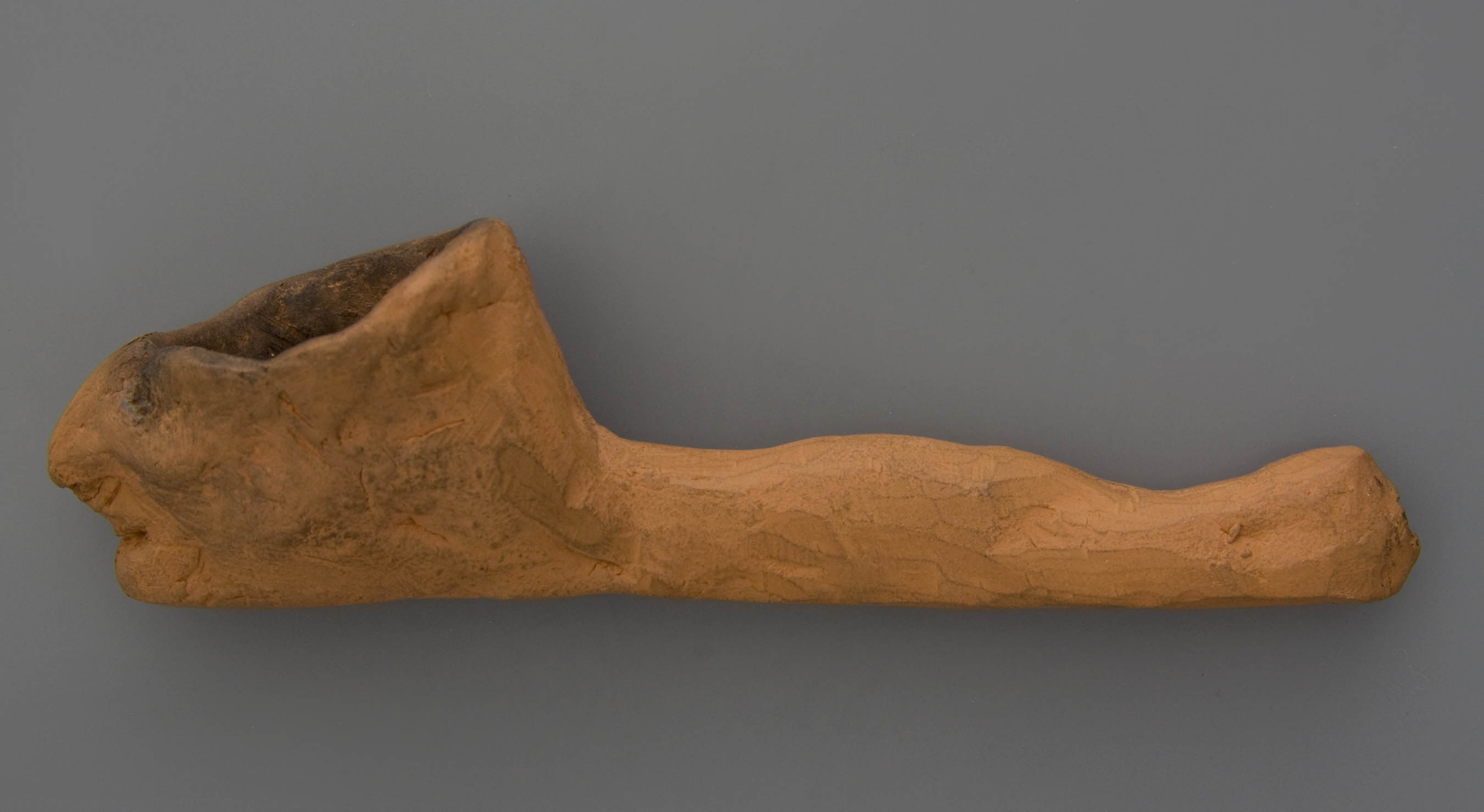
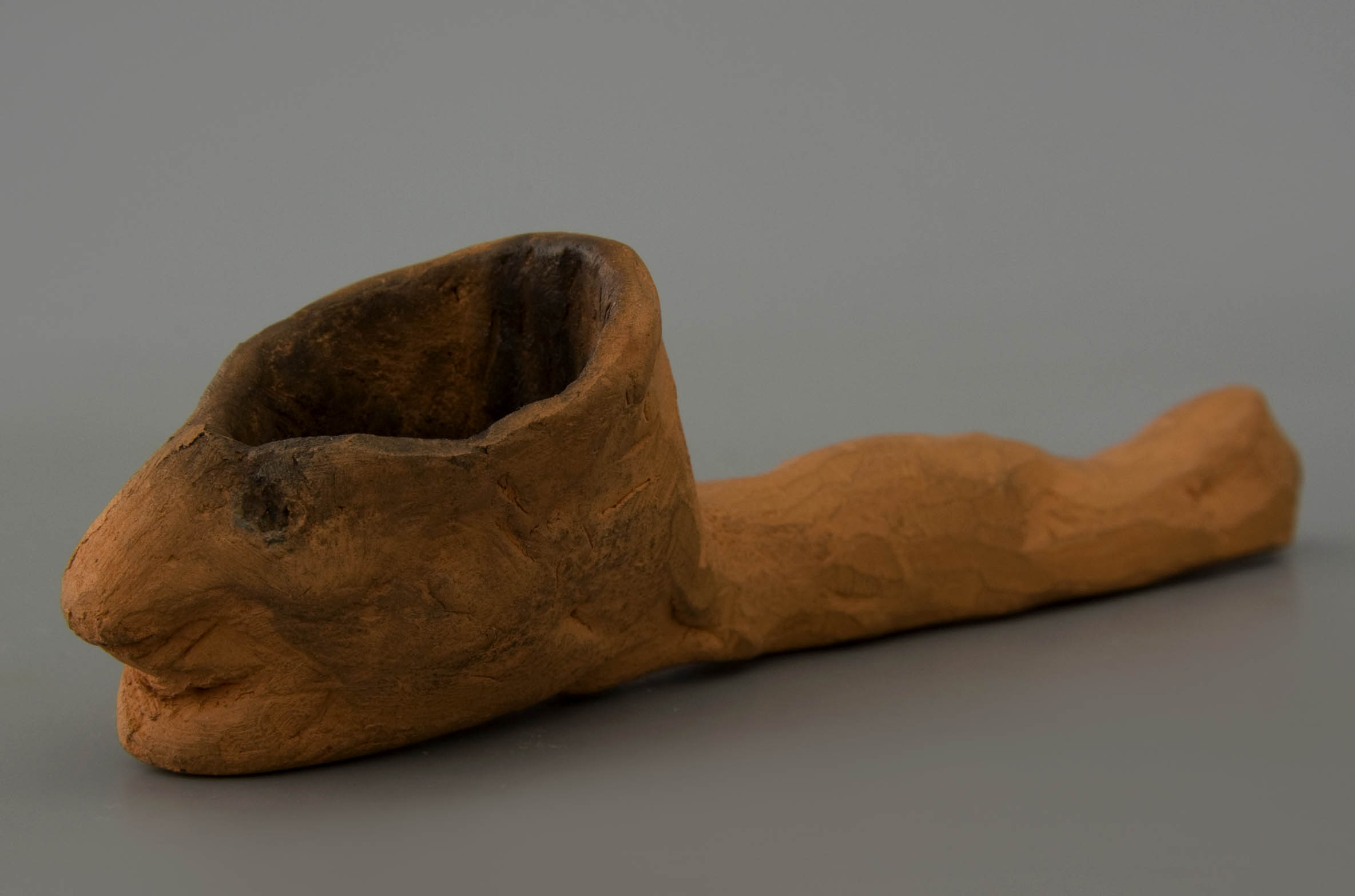
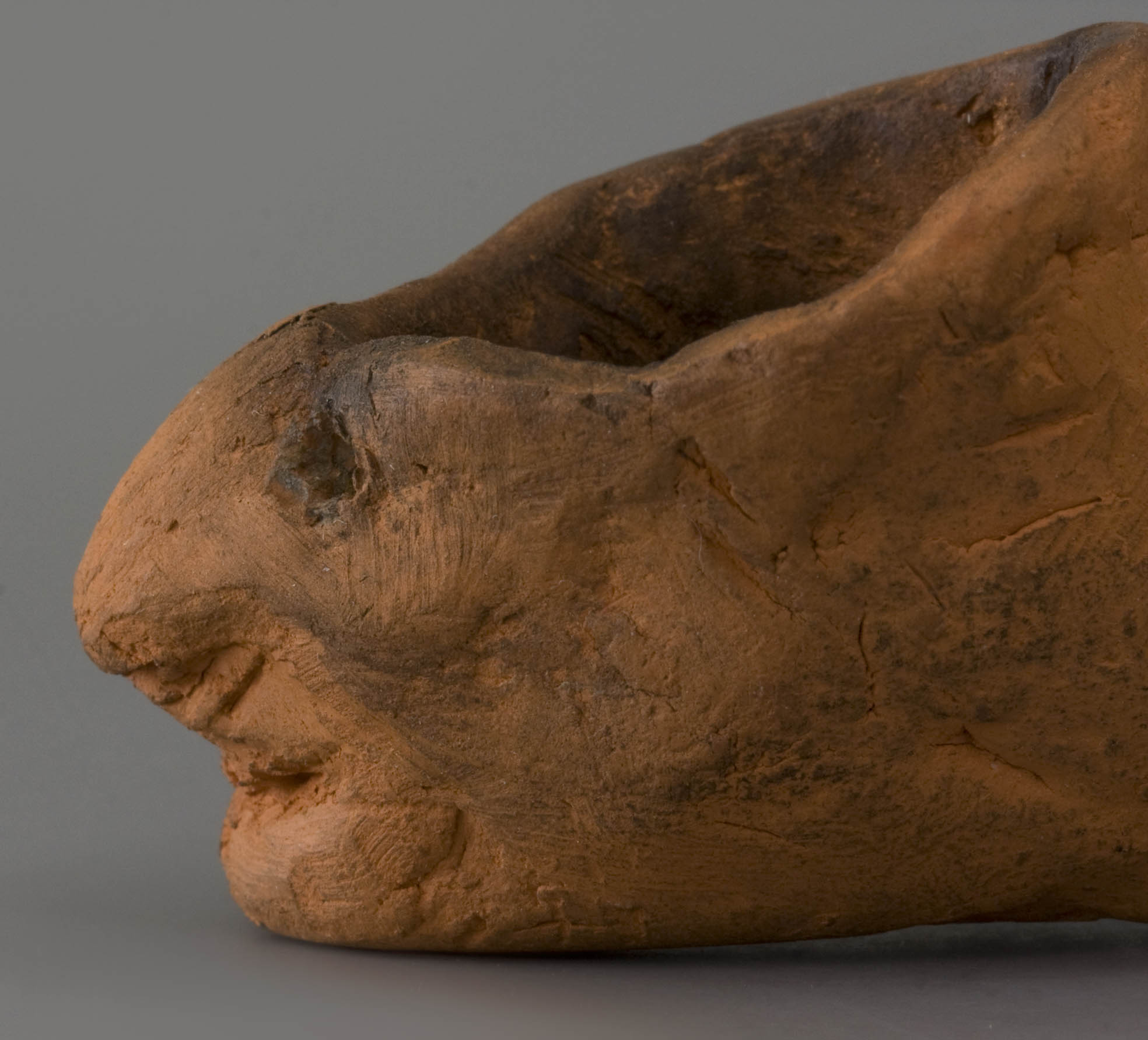
Not surprisingly, curator A. Witteveen from Utrecht asked his colleague Jan Schouten in Gouda for advice. In 1938 his predecessor G.C. Helbers made a presentation of the tobacco pipe when the museum The Blackamoor (De Moriaan) in Gouda opened as the Gouda Pipe and Ceramic museum. Schouten could easily help Witteveen. The Gouda museum happened to have such a primitive American Indian pipe in reserve and that item moved from the museum stores in Gouda to be showcased in Utrecht. By doing so it is unclear what the intention of Schouten was. Was he aware of the history behind that gift or was he just helpful?
We may conclude that a generation earlier curator Helbers of the Gouda museum had the same problem as Witteveen encountered around 1965. Helbers also lacked an example from the prehistory of smoking. Possibly someone in his circle was helpful, or Helbers may have filled the gap himself. Anyway, someone had simply invented a primitive smoking pipe that was formed in red backing clay. It should be said, that it was not uncommon for museums at that time to exhibit facsimiles, replicas or even objects in the style of. At that time most museum visitors were not so critical that they would have noticed. For unknown reasons and from unknown source, two copies of a so-called Indian pipe came into the hands of museum curator Helbers. One went directly into the show case, the other had to wait until 1965 when it could serve at the new Douwe Egberts museum.
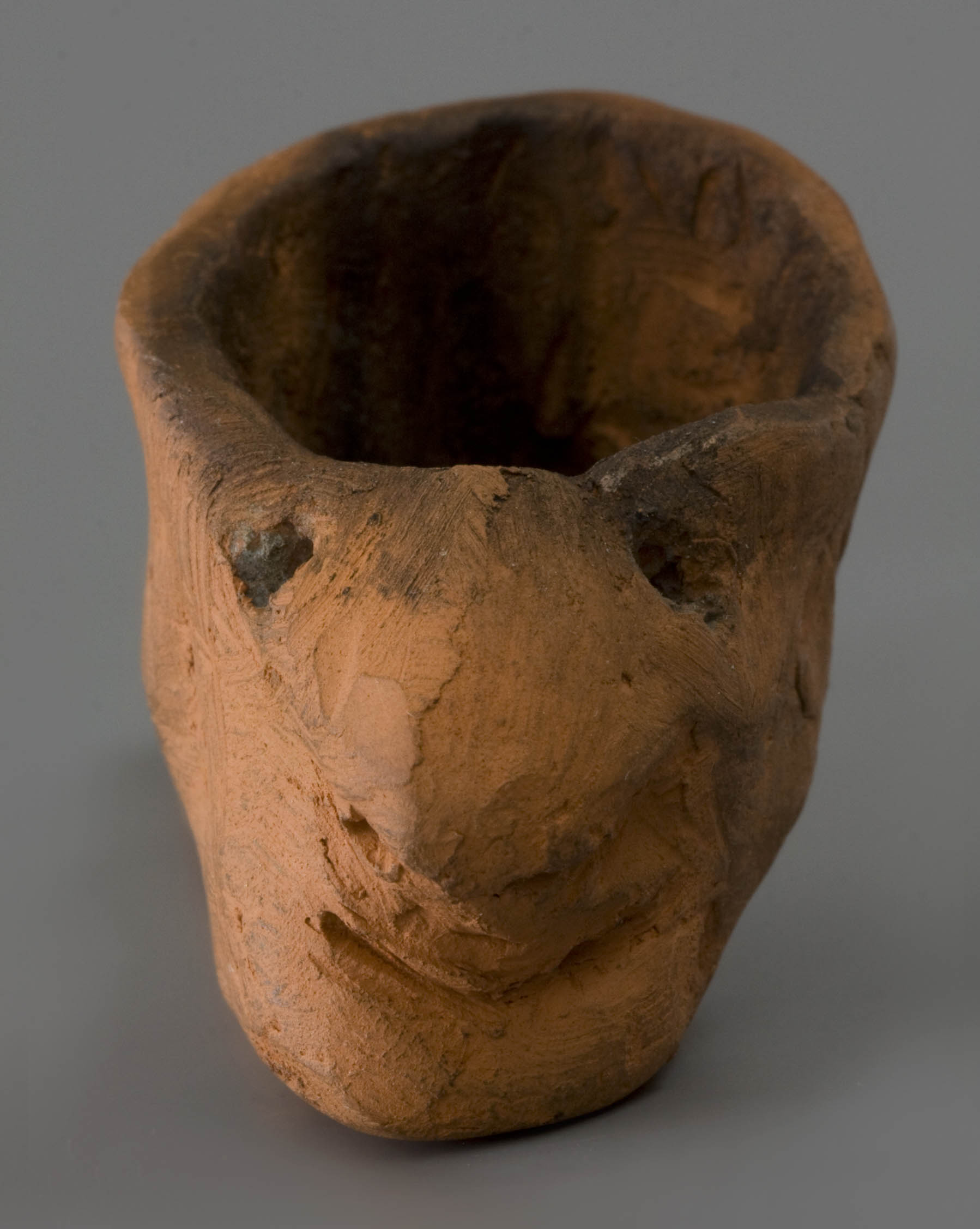
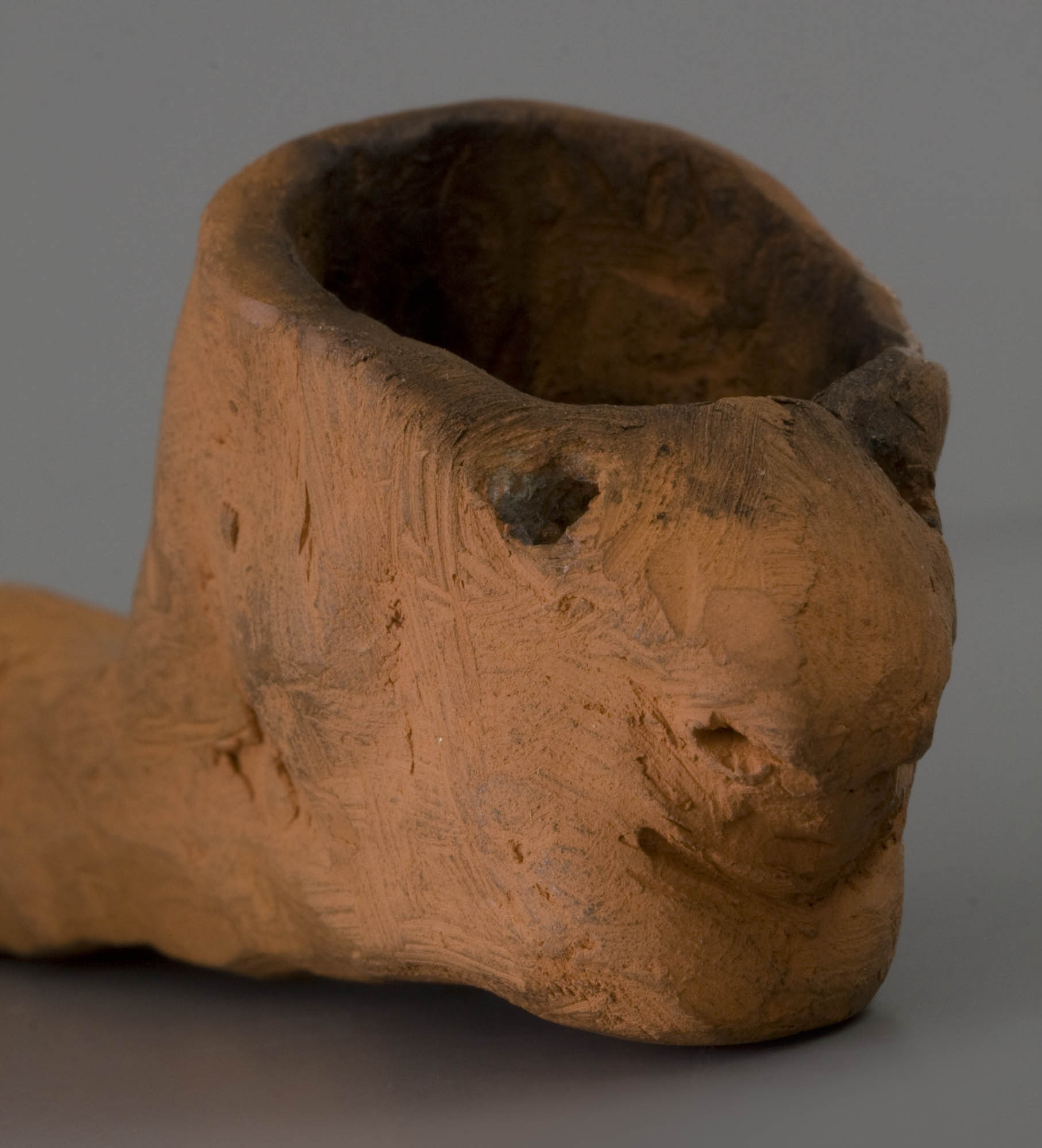
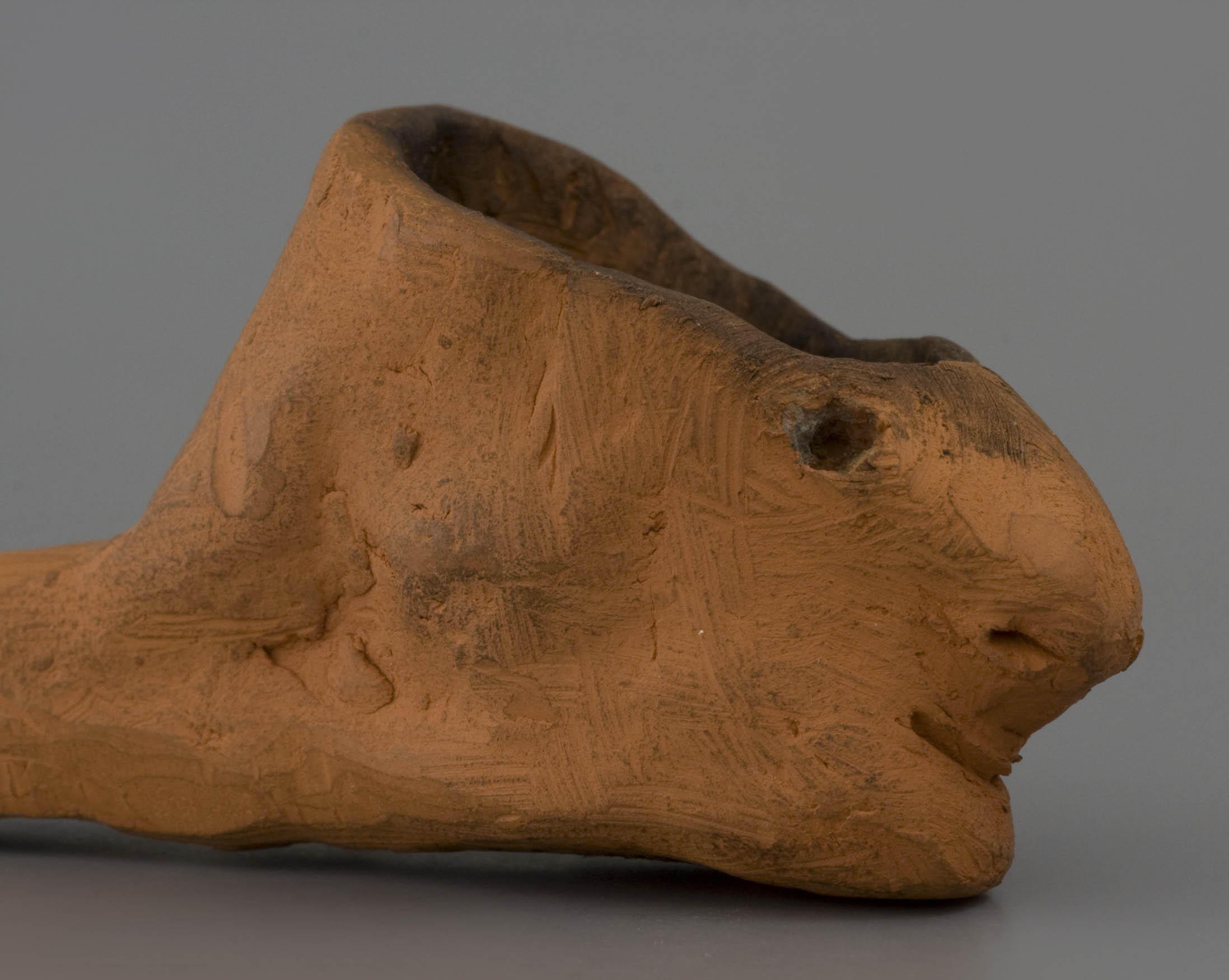
The pipe itself is a hand moulded specimen in fine red clay and has a primitive appearance, as it was believed to have been with the Indians (Fig. 1). The stem was kept short and for some reason made somewhat square of diameter. Being hand shaped, this resulted in a rather bumpy stem. The bowl of the item was at least as primitive as the stem, and has a low, wide shape with a likewise irregular surface. The creator thought that a decoration could not be left out, therefore he or she made a primitive face at the front of the bowl with simple indented eyes, coarsely sculptured nose - accidentally slightly too big - and a pressed line as mouth. This hand shaped pipe was then baked in a kiln which resulted in a bright orange-red colour.
The technical execution proves that the pipe is totally unsuitable for smoking. In every pipe a sufficient stem bore and a smooth connection from bowl to stem is of primary importance. When the smoke does not pass easily through the pipe, the object remains deprived of every comfort and enjoyment during the smoking ceremony. With this pipe it is especially the connection from the bowl that is made extremely careless, too small and most of all rough. Probably the passage of smoke will already be congested by tobacco crumb at the first time of smoking, which makes the pipe unusable.
To appear to be authentic one has provided this vile copy with a patina. At first the pipe was once held against a lighted match and so the bowl opening became blackish. Although the bowl opening faded somewhat sooty, the inside was still perfectly red. So this was rubbed with some black earth, as if the pipe was smoked or at least could seem of archaeological origin. The beautiful and subtle patina that we later learn to know from genuine native American pipes, has little to do with the primitive way of making this item look old.
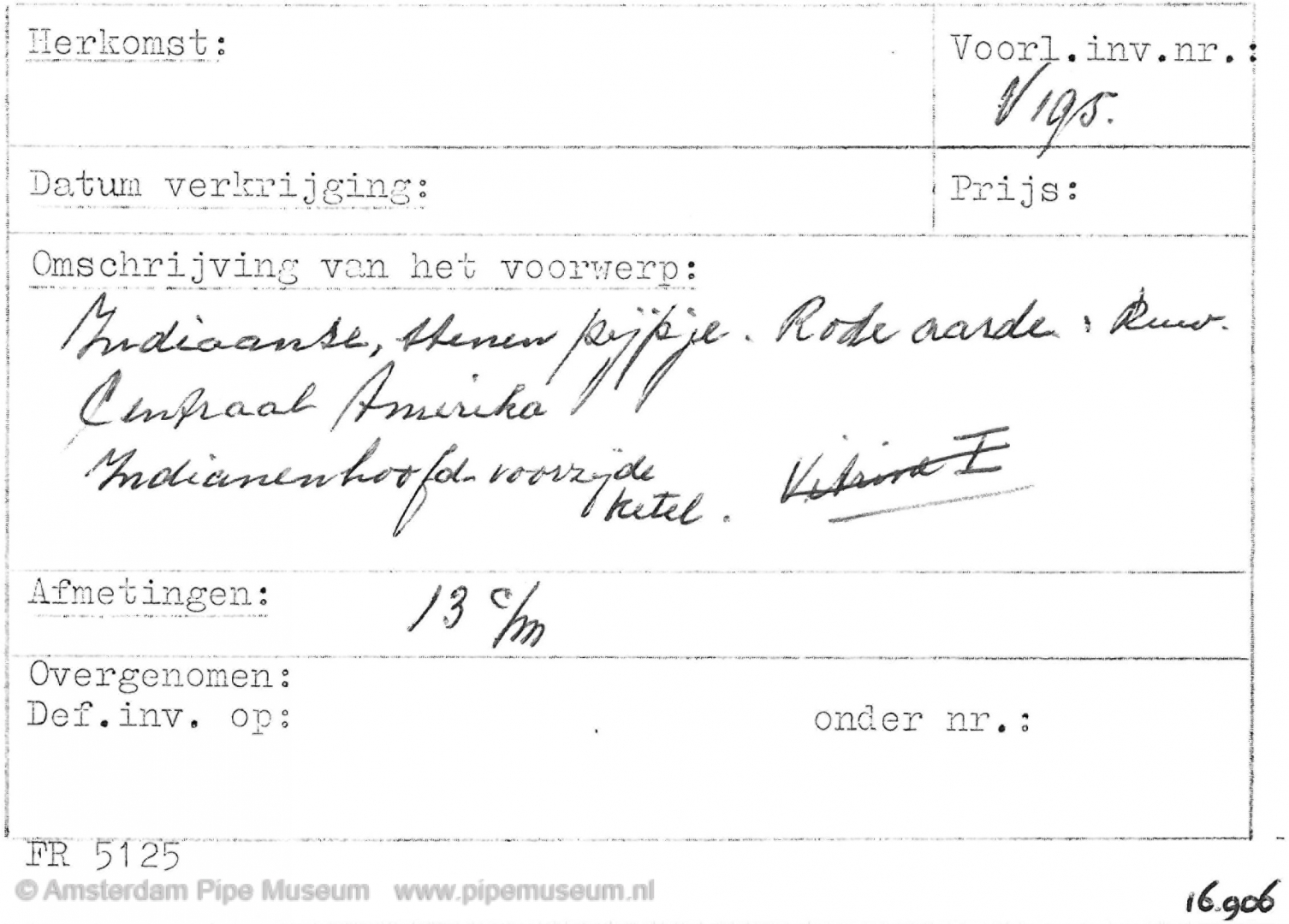
It is interesting to find out where the idea for this design came from. Some native American features are present, such as the slight elbow shape of the pipes from the Iroquois. In that region the face is a popular decorative motif, only then facing the smoker and particularly much better modelled. The square stem is reminiscent of the Cherokee pipes, however neither this aspect is sufficiently perfect, while a single bump in the stem resembles pipes from the Valley of Mexico. In short there are a few aspects of resemblance but no smoking pipe from American origin has a match with this newly created product.
Curator Helbers must have known. For long the thesis of Rembertus Westerhoff dated 1860 was present in the museum library, with in the back of the book two folding plates that show a variety of American pipes carefully modelled in stunning forms (Note 1). Larger parts of this scientific study are mere fantasy. Another book in the museum library is the impressive publication by Joseph McGuire from 1890 that illustrates almost all forms of real American Indian pipes (Note 2). Although the illustrations are just drawings in black and white, they were sufficient to offer at least some guidance. Apparently, the person who brought the pipes to the museum was given so much authority that the curator did not feel any urge to control the information on the available literature.
It remains a mystery that precisely this item was exhibited as centrepiece in the showcase, complete with a text label indicating a dating from before 1590. It is just a thought that D.A. Goedewaagen, one of the advisors of the museum and director of a well-known pipe factory, had the pipe made and baked in his own factory to bring it in as a joke. Or, maybe we should not search for an intellectual background: could it have been a schoolteacher that had the two pipes modelled by pupils after an inspiring visit to the Pijpen en Aardewerk Museum in Gouda? Anyway, it will always remain a question where the products came from. Surely, someone must have laughed in his sleeve because he knew it was not at all a serious historical object.
Nevertheless, the object was on view as an educational example and so it got a life of its own. This is evidently proved by an article in Het Vrije Volk (The Free People) newspaper, where in 1952 the Gouda version is fully discussed with the supposed dating from before 1590 (Note 3). Ten years later this pipe again got the interest of the press when it was depicted with the caption "Pipe from Virginia ± 1590" (Note 4). For visitors with a serious interest who visited the two museums, meeting up with a similar object was a source of recognition and created a clear picture of how the ‘real’ prehistoric American pipes have looked like.
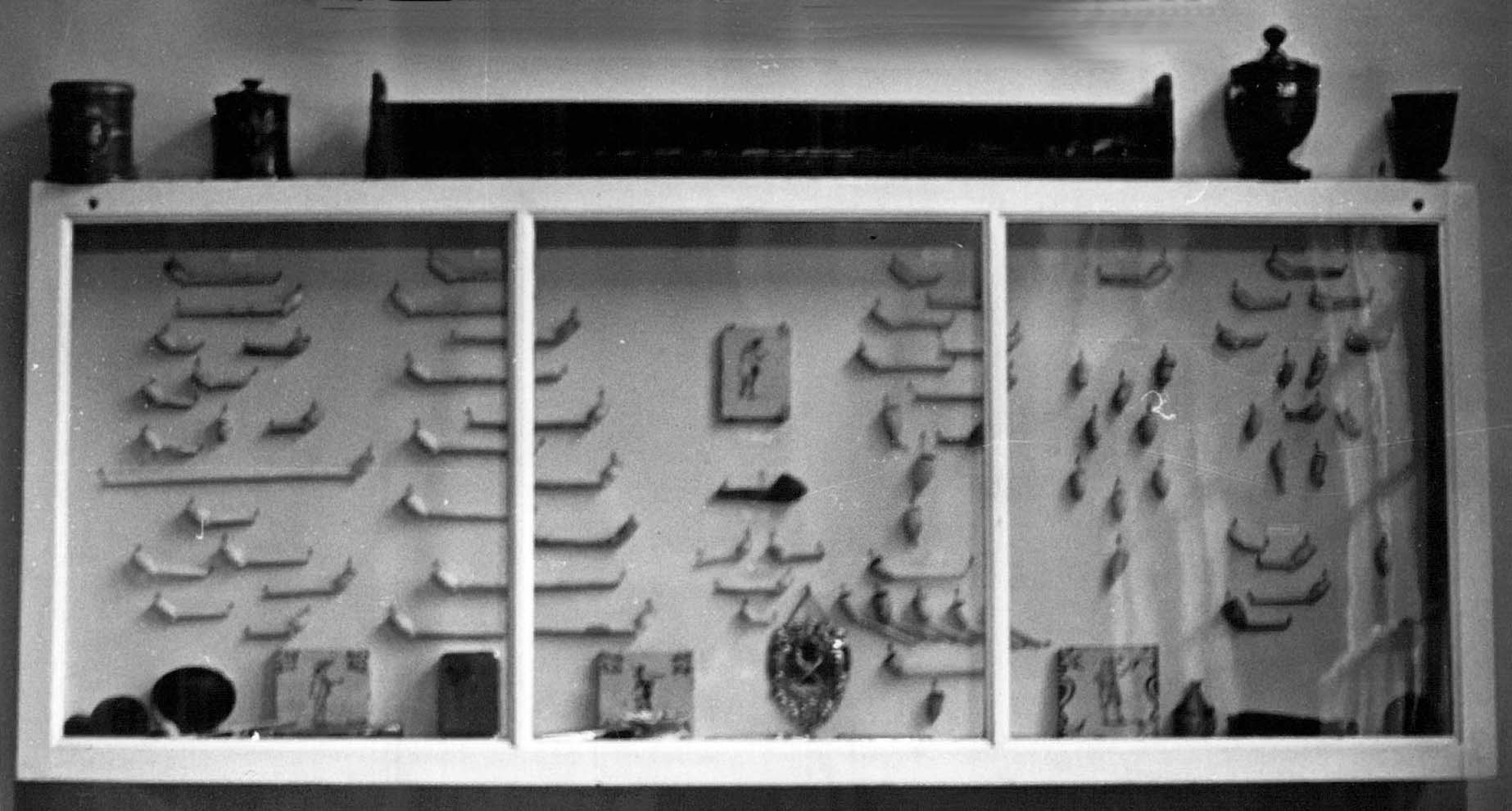
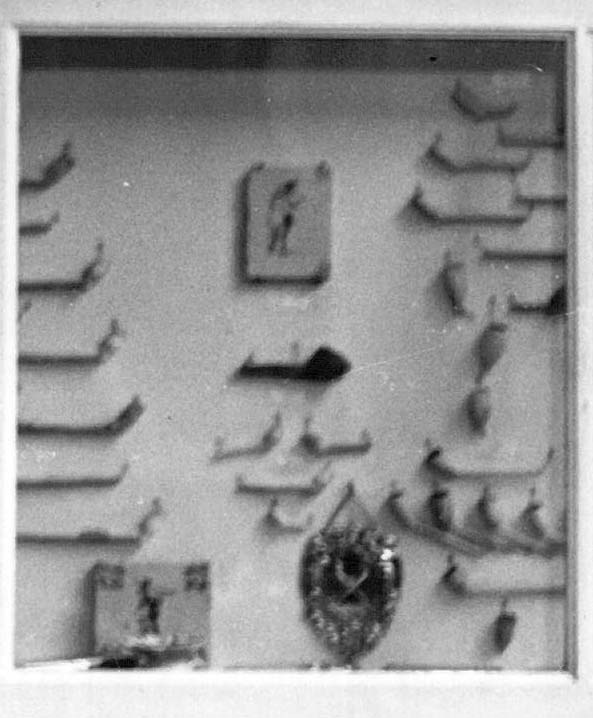
Whatever the history is, at both museums a fake pipe was shown, consciously or unconsciously exhibited to present something that never existed. And that was not for a short period of time. In The Gouda museum the false object was removed in 1988, fifty years after its opening, when a totally new presentation was created. With Douwe Egberts it took more than a decennium longer before the exhibition was dismantled at the final closing of the museum.
This year, during the sale of the Douwe Egberts collection the object reappeared. Nowadays no sensible person would think that it concerns an original American Indian object, but if this article was not written, no one would ever know of the non-professionalism of Dutch museums in the past, well-intentioned to instruct their visitors but in fact misleading them. Along with many other interesting pipes this object ended in the Pijpenkabinet. This Amsterdam museum holds numerous original pipes from various regions in Mexico and South America so that we don’t have to show imitations in relation to the early history of the tobacco. The discussed object became again an item for the spare collection, merely to serve as an example for the limited knowledge on this subject that still existed only a generation ago in the Netherlands.
© Don Duco, Pijpenkabinet Foundation, Amsterdam – the Netherlands, 2003.
Illustrations
- Hand moulded semi-tobacco pipe, the bowl shaped as a primitive human face. Red backed pottery. The Netherlands, 1938-1945.
Amsterdam, Pijpenkabinet collections Pk 16.906 - File card of the Douwe Egberts museum showing the description of a red stone Indian pipe from Central America.
Amsterdam, Pijpenkabinet documentation - The permanent display in the museum De Moriaan in Gouda, central in the show case the copy of the Indian pipe.
Amsterdam, Pijpenkabinet documentation
Notes
- Dr. R. Westerhoff, Oudheidkundige verhandeling en aanteekeningen betrekkelijk de kleine rookpijpjes, waaruit, naar 't volk hier en daar gelooft, de reuzen, alven, feeën en aardmannetjes oudtijds gerookt zouden hebben, Groningen, 1860.
- Joseph D. McGuire, Pipes and Smoking Customs of the American Aborigines, Based on Material in the U.S. National Museum, Ellicot City, Maryland, 1898.
- Het Vrije Volk, 03-11-1952. Under the photograph the date 1590.
- ‘De Goudse pijpmakers hebben geen opvolgers’, NRC, 29-04-1961.